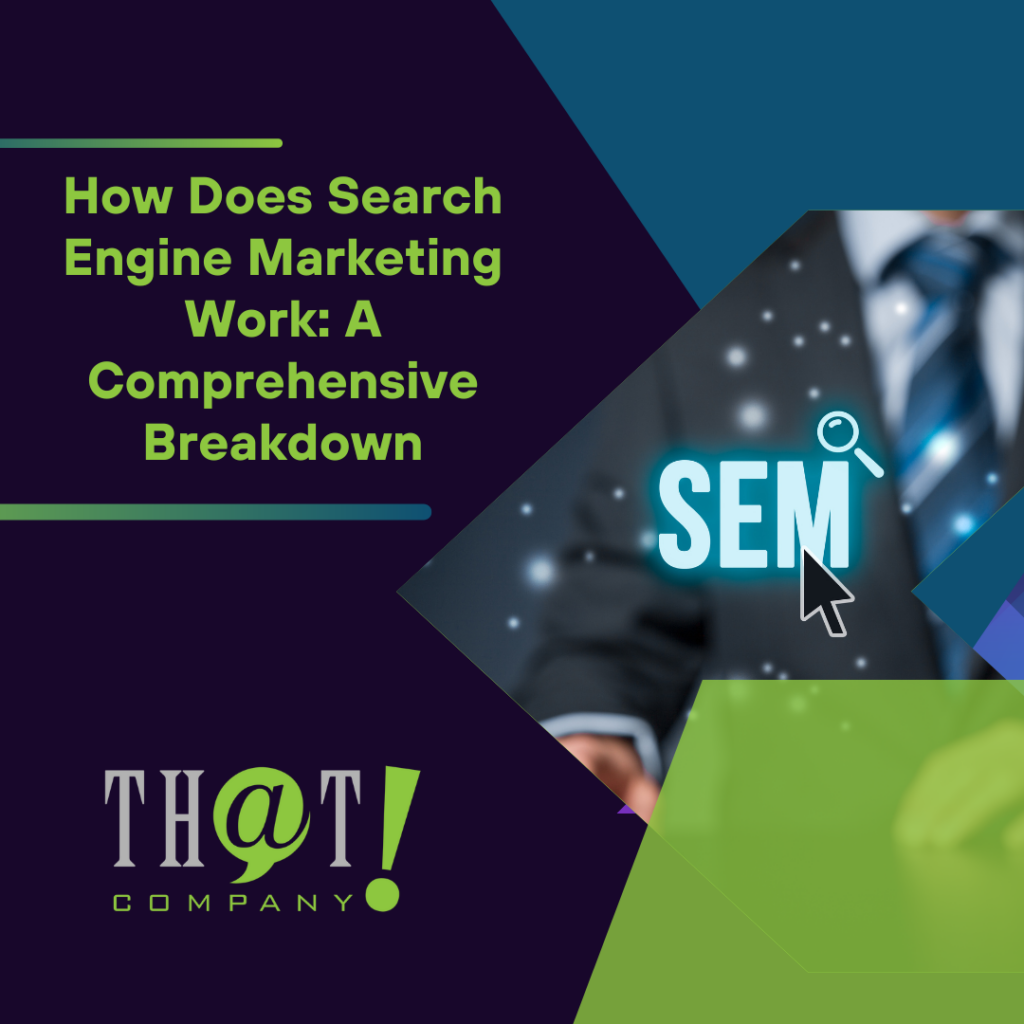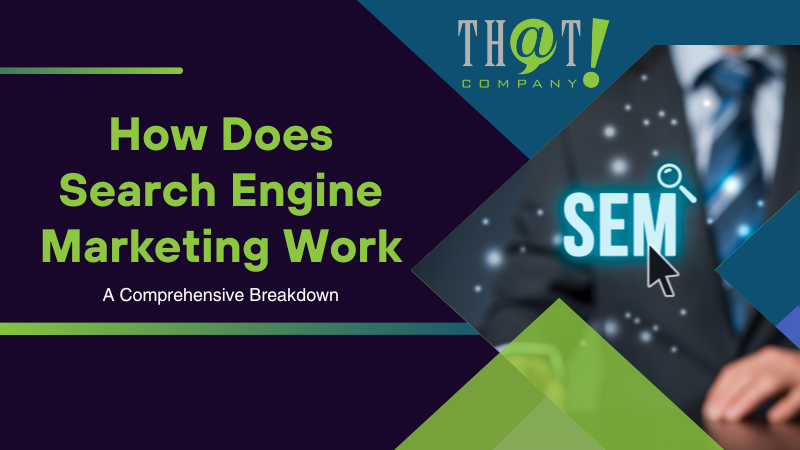
How does search engine marketing work? It’s a process where businesses harness the power of search engines to boost their visibility through strategic ad placements and keyword targeting. This article starts at the fundamental question – how does search engine marketing works – and guides you through SEM’s inner workings – from engaging the right audience with targeted ads to mastering the nuances of ad auctions and Quality Scores.
Essential Insights
- SEM optimizes visibility on SERPs by targeting the right keywords, understanding ad auctions and Quality Score, and leveraging organic and paid search through continuous refinement to drive traffic and conversions.
- Effective SEM strategies require keyword research, structured ad campaigns and ad groups, compelling ads and optimized landing pages, and integration with SEO for comprehensive visibility and results.
- Maximizing SEM ROI involves balancing budget and bid strategies, leveraging ad extensions, managing campaigns on platforms like Google Ads and Microsoft Advertising, and utilizing SEM tools to inform data-driven decisions.

Unveiling the Mechanics of Search Engine Marketing
SEM, at its core, is all about visibility. It’s about making sure your business’s products or services are seen on the search engine results pages (SERPs) and not just about being seen, though. It’s about being seen by the right people. That’s where keyword targeting, ad auctions, and Quality Scores come in.
While the world of SEM may seem like a complex maze, acquiring the right knowledge and resources can simplify your journey. The key lies in understanding how search engines like Google and Bing operate, and how to leverage this information to your advantage. It’s about understanding how to:
- Make search engines work for your business
- Optimize your site for search engines
- Conduct keyword research
- Create compelling and relevant content
- Build high-quality backlinks
- Monitor and analyze your SEM efforts
By mastering search engine optimization and these strategies, you can improve your search engine rankings and drive more targeted traffic to your website through organic search results, making search engine marketing work effectively for your business.
The Role of Keywords in SEM
Keywords are the compass that guides your SEM strategy. They represent the specific words and phrases that potential customers type into search engines while looking for offerings similar to what your business provides. The appropriate keywords guarantee ad visibility to your target audience and aid in effective budget management. The question is, how do we determine these keywords?
Tools like SEMrush’s Keyword Magic Tool and Google’s Keyword Planner come in handy for keyword research. They can help you:
- Uncover relevant keywords
- Give bid estimates to align with your advertising budget
- Provide insights into the search intent behind keywords, helping you to focus on commercial or transactional keywords that are more likely to result in purchases.
Understanding Ad Auctions and Ad Rank
Your ads don’t automatically show up on SERPs; they must earn their position. This is where the ad auction comes in. Every time a user conducts a search, an ad auction takes place. Ads are evaluated based on their Quality Score and proposed price, and the highest bidder wins the top spot.
The ad rank, which influences the placement of ads, is determined by the bid and Quality Score. This is where machine learning comes into play. SEM uses machine learning to understand user preferences, allowing it to target ads more effectively within the auction.
The Significance of Quality Score
The Quality Score serves as a crucial metric, evaluating the performance of your ads, keywords, and landing pages. It provides insights into the overall performance of your online advertising campaigns. It’s like a report card for your SEM efforts. And just like in school, a better Quality Score can lead to better outcomes. In this case, better ad placements, and lower costs in Google Ads auctions.
So, how can you improve your Quality Score? Start by focusing on:
- Ad relevance, which directly influences ad rankings, costs, and ROI
- Testing and finely-tuning your ad copy for effectiveness
- Making strategic budget decisions

Crafting an Effective SEM Strategy
Designing an effective SEM strategy resembles the process of piecing together a puzzle. Each piece plays a crucial role:
- Keyword selection
- Ad creation
- Landing page optimization
- Bid management
- Ad scheduling
- Ad targeting
And when all the pieces come together, the picture is clear: increased traffic, greater visibility, and more conversions.
One major advantage of SEM, particularly paid search, is its immediacy. Once your ads are approved, they can go live within a few hours. This can offer instant visibility and results. But an effective SEM strategy doesn’t stop there. It requires ongoing optimization, including the use of ad extensions and frequent updates, to maintain relevance and impact.
Selecting Targeted Keywords
Choosing appropriate keywords is a fundamental step in designing an effective SEM strategy. These are the queries and phrases that your intended audience types into search engines when in search of products or services that resemble what your business offers.. But how do you know which keywords to target?
This is where the utility of keyword research tools comes into play. Tools such as SEMrush’s Keyword Magic Tool and Google’s Keyword Planner can help you uncover relevant keywords and give bid estimates to align with your advertising budget. They can also help you understand the competition for keywords, allowing you to balance reach and competitiveness.
Structuring Ad Campaigns and Ad Groups
A successful SEM strategy involves more than just selecting the right keywords. It’s also about structuring your ad campaigns and ad groups effectively. Think of your ad campaign as a tree, with the ad groups as the branches. Each branch (or ad group) should be closely related, allowing for the creation of targeted and impactful ads.
And just as a tree needs pruning, so too does your ad campaign. Regularly review and understand your competitors’ advertising strategies. This can provide valuable insights that can guide the structuring and optimization of your own ad campaigns.
Creating Compelling Ads and Landing Pages
The creation of engaging ads and landing pages is a crucial aspect of all SEM strategies. Your ads are your first impression, so make them count. Craft your ad copy with creativity, brevity, and authenticity. Focus on relevance and enhancing the user experience.
And don’t forget about your landing pages. These are the pages that users land on after clicking your ad. They should be user-friendly, visually engaging, and optimized for speed. Ongoing optimization of landing pages is critical to increase relevancy to the user and improve the conversion rate.
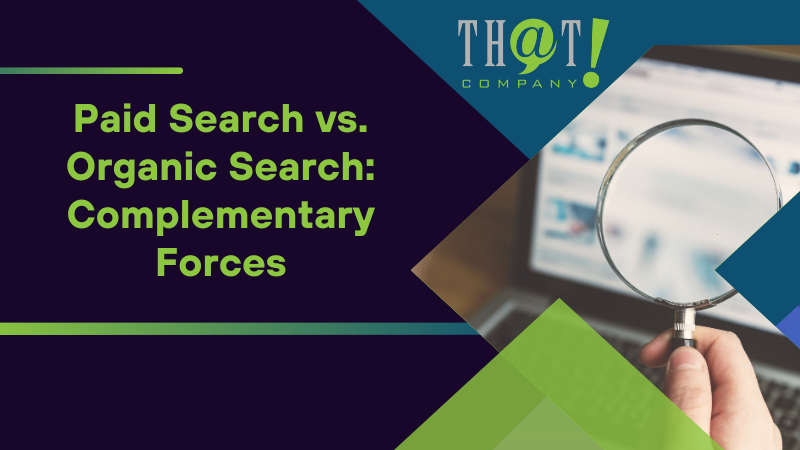
Paid Search vs. Organic Search: Complementary Forces
SEM can be compared to a two-sided coin. On one side, you have paid search. This involves paying for clicks and ad placements. On the other side, you have organic search. This involves optimizing your website to rank higher in organic (unpaid) search results. Both sides of the coin are essential for maximizing website visibility.
While SEM provides immediate visibility and targeted traffic, organic search builds a foundation for growth over time. Utilizing both paid and organic search tactics can lead to a balanced, effective SEM approach, leveraging the strengths of immediate impact and sustainable growth.
Incorporating SEM with SEO for Maximum Visibility
SEM and SEO aren’t opposites, they complement each other. In fact, they work best when used together. By integrating SEM with SEO, you can leverage the strengths of both approaches, using paid search data to refine SEO strategies and content creation.
Keywords and content should be matched to various points in the buyer journey. Use keyword research tools to check for an ideal medium level of search volume to balance reach and competitiveness. Incorporating search queries data from paid search campaigns can provide valuable keyword information that can be utilized to inform and improve SEO strategies, including paid search marketing.
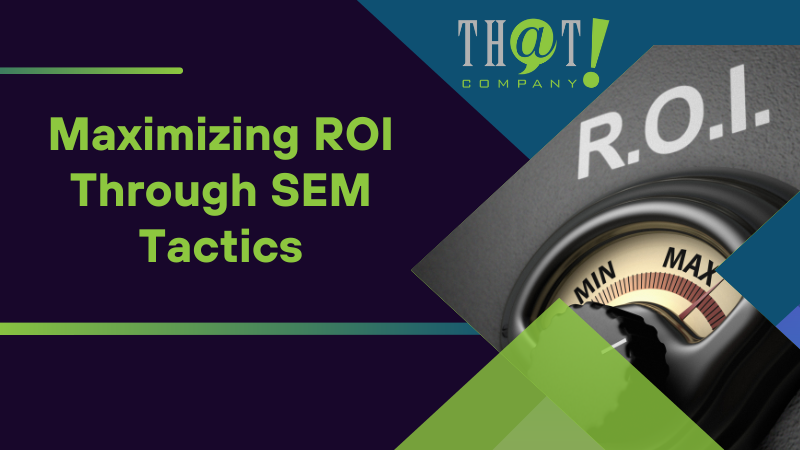
Maximizing ROI Through SEM Tactics
Optimizing return on investment (ROI) is an essential element of every SEM strategy. After all, you want to make sure you’re getting the most bang for your buck. This is achieved through efficient management of ad auctions and bids for targeted keywords, along with strategic monitoring of SEM campaigns.
But maximizing ROI isn’t just about managing your budget and bids. It’s also about ensuring ad relevance, which directly influences ad rankings, costs, and ROI. Testing various types and combinations of ad extensions, as well as frequent updates, are recommended practices for maintaining ad extension relevancy and impact.
Balancing Budget and Bid Strategy
Balancing your budget and bid strategy is like walking a tightrope. On one side, you have your budget. On the other, your maximum bids. You want to secure desired ad placement without incurring excessive costs.
Cost-per-click (CPC) is a key metric that determines the cost incurred for each click on an ad. It’s important to consider the associated CPC when selecting keywords to determine how much to bid in the auction process. SEM budgets should be dynamically adjusted based on the performance metrics of the campaigns to optimize spending and results.
Leveraging Ad Extensions for Enhanced Performance
Ad extensions are like the icing on the cake. They add extra information to your ads, such as your business’s location or phone number. This can increase your ad’s visibility and provide additional value and context, which can improve click-through rates and conversions.
There are many types of ad extensions, including:
- Call extensions
- Location extensions
- Sitelink extensions
- Callout extensions
- Structured snippet extensions
- Price extensions
- Review extensions
Each serves a different purpose to enhance ad relevance and user engagement.
Ad campaigns should be structured with closely related ad groups, careful selection of match types, and strategic use of ad extensions to enhance the effectiveness of paid ads.
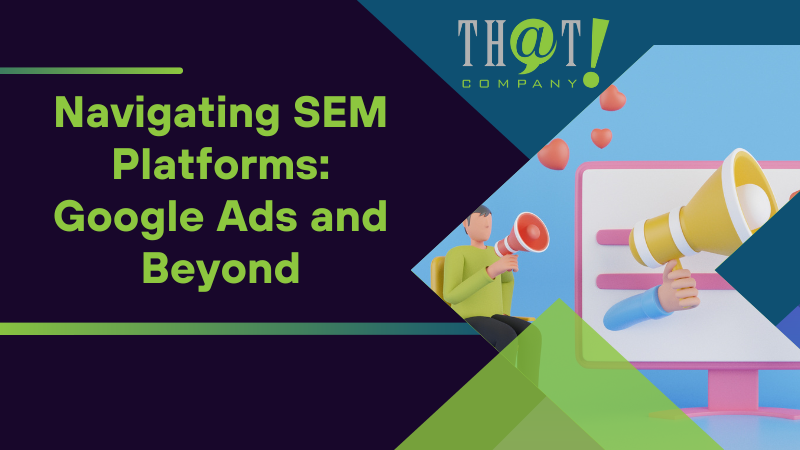
Navigating SEM Platforms: Google Ads and Beyond
Among SEM platforms, Google Ads reigns supreme. Formerly known as Google AdWords, Google Ads is a comprehensive SEM platform for creating paid advertising on Google’s search results. But it’s not the only player in the game.
Other platforms, like Bing Ads (now known as Microsoft Advertising), offer a competitive alternative to Google Ads. These platforms also use an auction process to determine where ads rank on their SERPs. By diversifying your SEM strategies across multiple platforms, you can reach a wider audience and boost your visibility. Furthermore, incorporating white label SEO outsourcing can help businesses enhance their online presence by leveraging specialized expertise and resources for more effective search engine marketing strategies.
Setting Up and Managing a Google Ads Account
Though the process of setting up a Google Ads account might appear overwhelming, it needn’t be so. Start by adding detailed business information, including your campaign goals and budget. You can also link existing YouTube and Google Business Profile accounts for more cohesive campaign creation.
Next, configure your billing details, including your country, time zone, and payment method. Finally, structure your Google Ads account for efficient management and optimal campaign tracking. Remember, you don’t have to start a campaign right away. Take the time to plan your SEM strategy and make sure you’re set up for success.
Exploring Alternatives: Bing Ads and Other Players
Although Google Ads is a preferred choice for SEM, it isn’t the only platform available. Bing Ads, now known as Microsoft Advertising, offers a competitive alternative. It provides a similar service to Google Ads, allowing you to create paid advertising on Bing’s search results.
Just like with Google Ads, you can use tools like SpyFu with Bing Ads. This allows you to:
- Analyze competitor keyword strategies
- Aid in the development of effective SEM campaigns
- Explore alternatives to Google Ads
- Diversify your SEM strategies
- Reach a wider audience

Monitoring and Measuring SEM Success
Monitoring and measuring your SEM strategy’s success is akin to verifying your direction with a compass while traversing the labyrinth of digital marketing. It helps you understand whether you’re on the right track and what adjustments need to be made. This involves continuous monitoring and adjustment of your SEM campaigns, as well as assessing key metrics like click-through rates, conversion rates, and return on ad spend.
Remember, SEM is not a set-it-and-forget-it strategy. It requires ongoing evaluation and adaptation. This will help you adapt to changing trends, consumer behaviors, and search engine algorithms, ensuring long-term success.
Key Performance Indicators for SEM
Key Performance Indicators (KPIs) function as the pulse-check of your SEM strategy. They include metrics like:
- Impressions
- Clicks
- Click-through rate (CTR)
- Conversions
These metrics are fundamental for assessing and refining the performance of your ad extensions and overall SEM strategy.
Proper setup of analytics and tracking is crucial for accurate measurement. This includes the use of UTM links. Engagement indicators, such as time spent on the website and bounce rates, can also provide valuable insights into potential issues with content or user experience.
Utilizing SEM Tools for Data-Driven Insights
In the dynamic digital environment, data reigns supreme. And SEM tools are the key to unlocking the power of this data. They can help you conduct keyword research, a foundational element of any digital marketing strategy, including SEM.
One such tool is Google Ads Keyword Planner. This tool can help you discover keywords pertinent to your industry and audience. By using SEM tools, you can uncover data-driven insights that can inform and improve your SEM strategy.

That! Company’s Approach to SEM Mastery
That! Company, a white label marketing agency, adopts a holistic approach towards Search Engine Marketing. They offer complete white label digital marketing services, engaging directly with clients under the agency’s brand. This approach enhances service personalization, fosters immediate feedback loops, and enables scalability.
Partnering with That! Company brings numerous advantages, including:
- Better customer lifetime value
- Avoidance of developing new products and departments from scratch
- Access to established distribution and marketing resources
With That! Company, you can rest assured that your SEM strategy is in the hands of seasoned experts.
Keep in mind that a white label company can help in search engine marketing by providing specialized services and expertise under your brand name. This allows businesses to offer comprehensive SEO and SEM solutions without needing to develop these capabilities in-house. By leveraging the knowledge and resources of a white label company, you can enhance your client’s online visibility, improve search rankings, and drive more targeted traffic to their websites, all while maintaining your brand identity and focusing on core business functions.

Summary
In summary, SEM is a powerful tool in the digital marketer’s toolkit. It involves a strategic combination of paid and organic search tactics to maximize website visibility. By leveraging keywords, ad auctions, Quality Score, ad extensions, and SEM tools, businesses can craft effective SEM strategies that deliver results. With the right partner, such as That! Company, businesses can navigate the complexities of SEM and achieve long-term success.

Frequently Asked Questions
What is the difference between SEM and SEO?
The main difference between SEM and SEO in Search Engine Marketing is that SEM involves paid tactics like PPC advertising, while SEO focuses on organic methods to enhance a site’s search engine ranking. Therefore, SEM requires a budget for advertising, whereas SEO does not.
What role do keywords play in SEM?
Keywords play a crucial role in SEM as they guide the targeting of ads and ensure that your ads reach the most relevant audience, effectively managing your advertising budget.
How does the ad auction process work?
The ad auction process occurs during user searches, where ads compete based on Quality Score and bid amount, with the highest bid winning the top spot on the SERP.
What is the benefit of integrating SEM with SEO?
Integrating SEM with SEO allows you to leverage the strengths of both approaches, using paid search data to refine SEO strategies and content creation for maximum website visibility.
What services does That! Company offer?
That! Company offers a variety of white label digital marketing services, such as SEO, PPC/SEM, and social media marketing, allowing for personalized service and prompt feedback.

